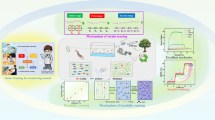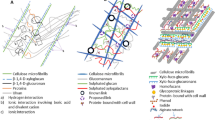Abstract
The discovery of a novel silk production system in a marine amphipod provides insights into the wider potential of natural silks. The tube-building corophioid amphipod Crassicorophium bonellii produces from its legs fibrous, adhesive underwater threads that combine barnacle cement biology with aspects of spider silk thread extrusion spinning. We characterised the filamentous silk as a mixture of mucopolysaccharides and protein deriving from glands representing two distinct types. The carbohydrate and protein silk secretion is dominated by complex β-sheet structures and a high content of charged amino acid residues. The filamentous secretion product exits the gland through a pore near the tip of the secretory leg after having moved through a duct, which subdivides into several small ductules all terminating in a spindle-shaped chamber. This chamber communicates with the exterior and may be considered the silk reservoir and processing/mixing space, in which the silk is mechanically and potentially chemically altered and becomes fibrous. We assert that further study of this probably independently evolved, marine arthropod silk processing and secretion system can provide not only important insights into the more complex arachnid and insect silks but also into crustacean adhesion cements.




Similar content being viewed by others
References
Aldred N, Scardino A, Cavaco A, de Nys R, Clare AS (2010) Attachment strength is a key factor in the selection of surfaces by barnacle cyprids (Balanus amphitrite) during settlement. Biofouling 26:287–299
Andersen SO (1970) Amino acid composition of spider silks. Comp Biochem Physiol 35:705–711
Cao Y, Wang B (2009) Biodegradation of silk biomaterials. Int J Mol Sci 10:1514–1524
Case ST, Powers J, Hamilton R, Burton MJ (1994) Silk and silk proteins from two aquatic insects. In: Kaplan D, Adams WW, Farmer B, Viney C (eds) Silk polymers, 544 ACS Symposium Series. Washington, DC, pp 80–90
Craig CL (1997) Evolution of arthropod silks. Annu Rev Entomol 42:231–267
Dicko C, Kenney JM, Vollrath F (2006) Beta-silks: enhancing and controlling aggregation in fibrous proteins: amyloids, prions and beta-proteins. Adv Protein Chem 73:17–53
Dixon IMT, Moore PG (1997) A comparative study on the tubes and feeding behaviour of eight species of corophioid Amphipoda and their bearing on phylogenetic relationships within the Corophioidea. Philos Trans R Soc Lond B Biol Sci 352:93–112
Edmonds D, Vollrath F (1992) The contribution of atmospheric water vapour to the formation and efficiency of a spider’s capture web. Proc Roy Soc London 248:145–148
Engster MS (1976) Studies on silk secretion in the Trichoptera (F. Limnephilidae). Cell Tiss Res 169:77–92
Foster-Smith RL, Shillaker RO (1977) Tube-irrigation by Lembos websteri Bate and Corophium bonellii Milne Edwards (Crustacea: Amphipoda). J Exp Mar Biol Ecol 26:289–296
Jahn TR et al (2010) The common architecture of cross-β amyloid. J Mol Biol 395(4):717–727
Jin HJ, Kaplan DL (2003) Mechanism of silk processing in insects and spiders. Nature 424:1057–1061
Kamino K (2001) Novel barnacle underwater adhesive protein is a charged amino acid-rich protein constituted by a cys-rich repetitive sequence. Biochem J 356:503–507
Kamino K (2008) Underwater adhesive of marine organisms as the vital link between biological science and material science. Mar Biotechnol 10:111–121
Kamino K, Odo S, Maruyama T (1996) Cement proteins of the acorn barnacle, Megabalanus rosa. Biol Bull 190:403–409
Khandeparker L, Anil AC (2007) Underwater adhesion: the barnacle way. Int J Adhes Adhes 27:165–172
Khurana R, Fink AL (2000) Do parallel beta-helix proteins have a unique Fourier transform infrared spectrum? Biophys J 78(2):994–1000
Kubelka J, Keiderling TA (2001) Differentiation of beta-sheet-forming structures: ab initio-based simulations of IR absorption and vibrational CD for model peptides and protein beta-sheets. J Am Chem Soc 123(48):12048–12058
Mondal M, Trivedy K, Kumar SN (2007) The silk proteins, sericin and fibroin in silkworm, Bombyx mori Linn. — a review. Caspian J Env Sci 5(2):63–76
Naldrett MJ, Kaplan DL (1997) Characterization of barnacle (Balanus eburneus and B. crenatus) adhesive proteins. Mar Biol 127:629–635
Nott JA, Foster BA (1969) On the structure of the antennular attachment organ of the cypris larva of Balanus balanoides (L.). Philos Trans R Soc Lond B Biol Sci 256:115–134
Okano K, Shimizu K, Satuito CG, Fusetani N (1996) Visualisation of cement exocytosis in the cypris cement glands of Megabalanus rosa. J Exp Biol 199:2131–2137
Rathore O, Winningham MJ, Sogah DY (2000) A novel silk-based segmented block copolymer containing GlyAlaGlyAla β-sheets templated by phenoxathiin. J Polym Sci A 38:352–366
Regier JC et al (2010) Arthropod relationships revealed by phylogenomic analysis of nuclear protein-coding sequences. Nature 463:1079–1083
Shillaker RO, Moore PG (1978) Tube-building by the amphipods Lembos websteri Bate and Corophium bonellii Milne Edwards. J Exp Mar Biol Ecol 33:169–185
Talbot P, Demers D (1993) Tegumental glands of crustacea. In: Horst MN, Freeman JA (eds) The Crustacean integument: morphology and biochemistry. CRC Press, Boca Raton, FL, pp 151–192
Tatham AS, Shewry PR (2003) Comparative structures and properties of elastic proteins. In: Shewry PR, Tatham AS, Bailey AJ (eds) Elastomeric proteins. Cambridge Univ, Press, UK, pp 338–351
Vollrath F (2000) Coevolution of behaviour and material in the spider’s web. In: Domenici P, Blake RW (eds) Biomechanics in animal behaviour. Bios, Oxford, pp 315–329
Vollrath F, Knight D (1999) Structure and function of the silk production pathway in the spider Nephila edulis. Int J Biol Macromol 24:243–249
Vollrath F, Knight D (2001) Liquid crystalline spinning of spider silk. Nature 410:541–548
Vollrath F, Porter D (2009) Silks as ancient models for modern polymers. Polymer 50:5623–5632
Vollrath F, Tillinghast E (1991) Glycoprotein glue beneath a spider web’s aqueous coat. Naturwissenschaften 78:557–559
Walker G (1981) The adhesion of barnacles. J Adhes 12:51–58
Wiegemann M (2005) Adhesion in blue mussels (Mytilus edulis) and barnacles (genus Balanus): mechanisms and technical applications. Aquat Sci 67:166–176
Zhao H, Sun C, Stewart RJ, Waite H (2005) Cement proteins of the tube-building polychaete Phragmatopoma californica. J Biol Chem 280:42938–42944
Acknowledgments
We are grateful to D. Porter (University of Oxford) for discussions and to K. Halcrow (University of New Brunswick) for advice on the gland morphology. We thank D.A. Johnston (Biomedical Imaging Unit, University of Southampton) for confocal imaging and D. Lunn (University of Oxford) for help with the statistical analysis. The University of London Marine Biological Station (Millport) assisted with amphipod collection and access to SEM. V. Storch (Ruprecht-Karls University Heidelberg) kindly provided access to the TEM facility, while Stelzner Illustration helped with the scientific drawings. We are grateful for financial support provided by the European Research Council (grant SP2-GA-2008-233409) and the AFOSR (grant F49620-03-1-0111). To Skippy.
Conflict of Interest
None
Author information
Authors and Affiliations
Corresponding author
Additional information
Communicated by: Sven Thatje
Rights and permissions
About this article
Cite this article
Kronenberger, K., Dicko, C. & Vollrath, F. A novel marine silk. Naturwissenschaften 99, 3–10 (2012). https://doi.org/10.1007/s00114-011-0853-5
Received:
Revised:
Accepted:
Published:
Issue Date:
DOI: https://doi.org/10.1007/s00114-011-0853-5




